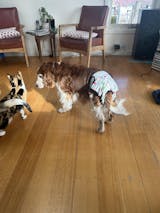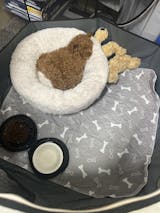Here Are Some Bite-Sized Puppy Checklist to Get You Through the Next Few Months
Bringing a new puppy for your home? Congratulations Buddy. Adding a fur baby to your family is a lot of fun and exciting time, whether it's your first one or you are adding another one to your family.
If it is your first one and you are feeling confused about what to do and what not to do then these small tips are just for you. We've researched and gathered knowledge on how to handle a new puppy in a new place. Read these points before taking a puppy as your new housemate. These Tips are highly effective when you are thinking about making a fur baby your friend.

Here are some bite-sized puppy tips to get you through the next few months.
1. Get a crate or playpen. It makes house training much easier. Especially crate that doubles as a playpen which is light, portable and easy to use.
2. Let your puppy sleep in your bedroom, at least for the first few nights. This whole experience is pretty scary for a pup, so it’s best not to make him sleep in the laundry room just yet. Put the crate next to your bed so you can reassure him.
3. Baby gates are your friend. Use them to keep the puppy out of places you don’t want her to destroy.
4. Supervise, supervise, supervise! If you cannot watch him like a hawk, he needs to be in his crate or in his “room,” see below.
5. Set up a puppy room for when you can’t supervise. Pick a small area like the bathroom or kitchen, block it off with baby gates. Add a bed in one corner. And if you need to leave him home alone longer than he can hold it, put pee pads or a dog “toilet” in another.
6. Pick a bathroom spot. If you don’t want Sparky pooping all over the yard as an adult, pick one area and take him directly there when it’s potty time.
7. Set a daily routine. House training proceeds more smoothly if your puppy knows what to expect from her day.
8. Check out puppy socialization classes in your area. Your pup will learn some basic obedience, but the real benefit of well-run puppy classes is socialization with other puppies and people.
9. Don’t believe everything you read on the internet. Not all advice is good advice. Take everything with a grain of salt. Even my advice!
10. Make sure everyone is on the same page. Discuss the puppy rules with your whole family. Figure out who will do what, and when. Pick one set of training cues and stick with them.
11. Play some puppy training games.
12. Don’t encourage behavior that you’ll regret when he gets big. Jumping up is cute when Sparky weighs ten pounds. It won’t be cute when he’s 60 pounds.
13. Get your pup used to handling from day one, gently touching feet, nails, tail, ears, mouth, teeth, and belly with love. Your vet will thank you.
14. Start grooming early on. For the same reason as above.
15. Let your puppy meet at least two new (friendly and gentle) people every day.
16. Take your puppy to the pet store. Great socialization opportunity. Hold her in your arms and off the floor until she’s had all her puppy shots.
17. Introduce your pup to all kinds of novel things. People in funny hats. Remote control cars. Kids playing. Agility equipment. Balloons. Cats. Car rides.
18. Socialize, don’t traumatize. Introduce new experiences slowly and never let your puppy get overwhelmed. Click here to read our beginner’s guide to puppy socialization.
19. Invite friends and family to meet-the-puppy parties.
20. Baby carrots make great chews for teething puppies.
21. Reward good behavior, don’t wait for bad behavior. Reward the puppy when you see him doing something you like. Don’t wait until he’s misbehaving to give him attention.
22. Avoid the dog park. In addition to putting your under-vaccinated puppy at risk for disease, many dogs at the dog park are quite rude by canine standards. A couple bad experiences could ruin your puppy’s opinion of her own species. Save that for when she’s older and has had lots of good socialization experiences.
23. Ditch the food bowl. Feeding your puppy out of food-dispensing puzzle toys will keep her busy (and out of trouble) longer, and provide much-needed enrichment.
24. Pick up anything you don’t want destroyed. If it’s on the floor, it WILL be chewed.
25. Get your puppy microchipped. It’s your best chance at being reunited with your dog if he ever gets lost. You can get this done for around $25 at your vet or local shelter.
26. Focus on what you want, not what you don’t want. For example, teach your puppy to sit when greeting people. Don’t just yell at her for jumping up. We teach a simple method for this in our Puppy Survival School program.
27. Watch your puppy’s poops. Disgusting? Yes. But it could save your puppy’s life. If you notice anything like diarrhea or blood, talk to your vet.
28. Provide lots of toys. Get a variety to see what kind your puppy likes best.
29. Provide lots of delicious chews. Things like bully sticks, pig ears, and flavored Nylabones. These will satisfy your pup’s need to chew, and make her less likely to chew on your valuables.
30. Rotate through the dog toys. Let your puppy have three or four toys at a time. Changing up the toy selection will keep Sparky interested.
31. Got an older dog or cat? Give them a puppy-free place to themselves. Life with a new pup can be overwhelming for everyone, including your other pets. Make sure they have the ability to escape the madness if they need to.
32. If you think your puppy needs to go potty at all, don’t hesitate to take him outside! You’d be surprised how often puppies need to go sometimes.
33. Practice separation. As tempting as it is, don’t let Sparky be glued to your side all day. Letting your puppy have time to himself in his crate or room may help prevent separation anxiety.
34. Don’t spend a lot of money on a fancy bed just yet. Your puppy will almost certainly chew up and/or pee on their bedding. Use old towels or blankets that you don’t mind getting destroyed, at least until the pup is a bit older.
35. Don’t worry too much when your puppy chews on you. Puppies bite. Sometimes painfully! But it’s not aggression, and this phase doesn’t last forever.
36. For pet messes, use an enzyme-based cleaner like Nature’s Miracle. Other types of cleaners don’t completely destroy the scent, so the puppy may try to eliminate in the same spot again.
37. Visit the vet. Take your pup for a visit when she doesn’t have an appointment. Bring some treats and ask the office staff to give her some. Make the vet’s office a fun place! (call ahead first to make sure this is okay)
38. As a general rule of thumb, the number of hours a puppy can “hold it” is his age in months plus one. So a two month old puppy should be crated for a maximum of three hours at a time (during the day. When they sleep at night, puppies can usually hold it for longer).
39. Leave the TV or radio on when you leave your puppy home alone.
40. Teach good leash manners early. Better to teach your puppy to walk nice on leash than to teach your adult dog to stop pulling on leash.
41. Remember that your puppy is a baby – don’t ask too much of her. Don’t worry about whether she’ll perform a perfect sit/stay or heel. There will be plenty of time for that when she’s older. Focus on socialization, building a relationship, and having fun.
42.Take lots of pictures. Despite the fact that it seems to last forever when you’re in the middle of the sleep deprivation and potty training stage, puppyhood goes by fast. And we always miss it when it’s over. (And tag us in your puppy pics @drypawsco on Instagram!)
43. Be prepared for your pup to become a whole different kind of obnoxious around age 6-10 months. Adolescence is sometimes even more challenging than puppyhood. Have fun with your teenage dog!
🐾🐾🐾🐾🐾🐾
As part of joining our Pups With Benefits program by purchasing from us, we offer a 25% discount on all products in store for our pup family.
Just use PUPSWITHBENEFITS at checkout to claim
drypaws.com.au
🐾🐾🐾🐾🐾
If you have any potty training questions, feel free to leave them in the comments in our secret puppy training facebook group and we will try to get back to you with helpful advice!!
















